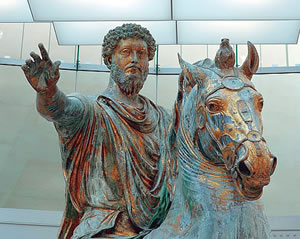Equestrian statues in Rome

The only great equestrian statue of Roman times that has come to this day is that of Marcus Aurelius; the splendid jewel of fusion art in Imperial Rome has been saved as it was believed that the character represented was Constantine because the statue was found near the Lateran where was the domus of Helena, mother of Constantine. But where Elena's domus stood there were Horti of Lucilla, the mother of Marcus Aurelius, and almost certainly the statue ornamented Lucilla's garden.
We know that in Rome, as well as that of Marcus Aurelius, there were many other equestrian statues; Still in the V-VI century AD. in Rome was visible, according to Curiosum urbis Romae, 22 equi magni ie equestrian statues that Cassiodoro recommended must be kept with the same caution as the cure with which they appear dedicated.
In the Roman Forum there were the equestrian statues of Marcius Tremulus, Diocletian and Constantine, the two emperors to whom the great resumption of Rome in the Late Empire age, as well as that of Constantius II and, finally in the Trajan Forum there was the gigantic statue of Trajan.
In 306 BC the Roman Senate decided to appoint Quintus Marcius Tremulus consol in the year and winner on Ernici, the honor of an equestrian statue that was erected in front of the Temple of Castor.
The bronze statue was made according to the icongraphy that the sculptor Lisippo invented for the achievement of the famous turma Alexandri
, a majestic bronze group representing the 25 knights who died in the Battle of Granico of 334 BC, also known as the Lisippo Group. The great bronze group had been commissioned by Alessandro to Lisippo to honor his 24 fallen comrades and then placed in the sanctuary of Dion in Macedonia.
What made Lisippo's work a reference model for successive equestrian monuments was the animation and variation of the knights 'gestures, the horses' march, the inventions of the fallen and overwhelmed enemies that served to support the horse scaffolds in movement and the physiognomy of faces that were in fact real portraits. When Quintus Cecilius Metellus submitted Macedonia in 146 BC he came back with a great booty including the equestrian statues of Lisippo, which he then put in the Porch that he built and which after a century was expanded by Augustus who dedicated it to his sister Octavia. Certainly the statues suffered the looting of the Visigoths and the Vandals or might have been fused as has happened to many precious metal objects since the Middle Ages.
In 1849 it was found a magnificent horse in Greek school bronze dated to the fourth century and was assumed to be one of the horses of Lysippos. Recent studies attribute it to another Greek artist, Egia who was master of Fidia and who worked in Rome. The model created by the Greek sculptors wanted to represent values such as heroism by exalting the knight who was the winning champion, on the contrary Roman iconography was more static though not rigid as in the 7th-6th century BC.
Sometimes compromise solutions were chosen such as Julius Cesare's equestrian statue (also this one disappearance) that was erected in the Caesar's Forum, in front of the Venus Genitrice Temple, and was made using a bronze statue of Bucephalus, horse of Alexander the Great, to which a knight was added with the traits of Caesar ...
Sign up and read the rest of the article!
by M.L. ©ALL RIGHTS RESERVED (Ed 1.0 - 14/04/2017)






